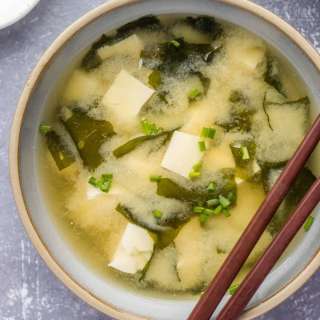
Cabbage and Onsen Tamago Miso Soup
User Reviews
4.7
27 reviews
Excellent

Cabbage and Onsen Tamago Miso Soup
Report
This Cabbage and Onsen Tamago Miso Soup is a hearty and flavorful soup you can easily make in 15 minutes or less! We‘ll use the microwave to make the silky poached egg (onsen tamago) and speed things up, but the result is just as satisfying.
Share:
Ingredients
- ¼ onion
- 3 cups water (for the dashi; you can substitute Awase Dashi or Vegan Dashi and skip the dashi packet)
- 2 dashi packets (in a pinch, you can use dashi powder; skip for vegan/vegetarian)
- ⅛ head green cabbage
- 3 Tbsp miso (any type; plus more, to taste)
- 3 large eggs (50 g each w/o shell)
For the Garnish
- 1 green onion/scallion
- shichimi togarashi (Japanese seven spice) (optional; for a spicy kick)
- Japanese sansho pepper (optional; for a spicy kick)
Instructions
- Gather all the ingredients. I made 2 onsen tamago (silky poached egg) today.
- Remove the core of ¼ onion and cut into thin slices.
- To a medium saucepan, add 3 cups water, the sliced onion, and 2 dashi packets. Cover the saucepan with a lid and bring it to a boil on medium heat.
- Remove the core of ⅛ head green cabbage and cut into small, ¾-inch (2-cm) squares. Discard any tough, dense pieces or reserve them for other recipes. Alternatively, you can add them to the saucepan earlier than the leafy parts to give them extra time to cook and soften.
- Cut 1 green onion/scallion in half widthwise and diagonally cut into thin slices.
- Once the water is boiling, shake the dashi packets with cooking chopsticks to release more flavor. Reduce the heat to medium low and cook, covered, for 4–5 minutes. Then, discard the dashi packets.
- Add the cabbage and cook, covered, until both the onion and cabbage are tender, about 4–5 minutes.
To Make the Onsen Tamago
- While cooking the onion and cabbage, prepare the onsen tamago with 3 large eggs (50 g each w/o shell). We‘ll poach one egg at a time. First, crack 1 large egg in a small, microwave-safe glass bowl. Use a bowl similar in shape to a standard rice bowl or miso soup bowl that‘s rounded and somewhat deep with sides that go straight up. Next, pour some water around the edges of the bowl, pushing the egg to the center.
- Pour enough water on top of the egg yolk to submerge it completely. I use a total of 100 ml of water for this particular bowl. Then, gently puncture the yolk with a toothpick to keep it from exploding during cooking.
- Place the bowl at the edge of the microwave tray. Microwave at 500W (I use half power or P5) for 90 seconds, or until the egg white JUST solidifies and turns white. The egg yolk should be pinkish and runny at this stage since it takes longer to solidify than the egg white. DO NOT OVERCOOK. If your egg white is still transparent, microwave for 5 seconds more and check again. The poached eggs should have silky egg whites and custard-like yolks.
- Immediately scoop out the onsen tamago with a slotted spoon, drain the cooking water, and transfer it to a small bowl. Don‘t keep the egg in the cooking water, as the remaining heat will continue to cook it. Repeat the same process for the remaining eggs.
To Add the Miso
- When the cabbage is tender, turn off the heat and add 3 Tbsp miso: Put the miso in a ladle, add hot stock to the ladle, and stir with chopsticks to dissolve completely. Alternatively, you can use a fine-mesh miso strainer and/or a miso muddler to dissolve it faster. Next, taste the soup and add more miso if needed. If it‘s too salty, add water or dashi (if you have any) to dilute.
To Serve
- Serve the miso soup in individual bowls, place the onsen tamago on top, and garnish with chopped green onions. Sprinkle with shichimi togarashi (Japanese seven spice) and Japanese sansho pepper, if you enjoy a bit of a spicy kick.
To Store
- It‘s best to consume all the miso soup right away because it loses aroma and taste over time. If you‘d like to keep leftovers, store the soup and onsen tamago separately. Cool the soup to room temperature (no longer than 4 hours), store in an airtight container, and keep for up to 2 days in the refrigerator or 2 weeks in the freezer. When ready to use, reheat in a pot over medium heat, but do not boil. Store the onsen tamago in an airtight container for 1–2 days in the refrigerator. When ready to use, bring to room temperature. To heat it further, place the container with the egg in another bowl of warm water for 10 minutes. Do not reheat more than that; otherwise, the heat will cook the egg.
Nutrition Information
Show Details
Calories
109kcal
(5%)
Carbohydrates
7g
(2%)
Protein
8g
(16%)
Fat
6g
(9%)
Saturated Fat
2g
(10%)
Polyunsaturated Fat
1g
Monounsaturated Fat
2g
Trans Fat
0.02g
Cholesterol
186mg
(62%)
Sodium
530mg
(22%)
Potassium
181mg
(5%)
Fiber
2g
(8%)
Sugar
3g
(6%)
Vitamin A
321IU
(6%)
Vitamin C
15mg
(17%)
Calcium
54mg
(5%)
Iron
1mg
(6%)
Nutrition Facts
Serving: 3Serving
Amount Per Serving
Calories 109 kcal
% Daily Value*
| Calories | 109kcal | 5% |
| Carbohydrates | 7g | 2% |
| Protein | 8g | 16% |
| Fat | 6g | 9% |
| Saturated Fat | 2g | 10% |
| Polyunsaturated Fat | 1g | 6% |
| Monounsaturated Fat | 2g | 10% |
| Trans Fat | 0.02g | 1% |
| Cholesterol | 186mg | 62% |
| Sodium | 530mg | 22% |
| Potassium | 181mg | 4% |
| Fiber | 2g | 8% |
| Sugar | 3g | 6% |
| Vitamin A | 321IU | 6% |
| Vitamin C | 15mg | 17% |
| Calcium | 54mg | 5% |
| Iron | 1mg | 6% |
* Percent Daily Values are based on a 2,000 calorie diet.
Genuine Reviews
User Reviews
Overall Rating
4.7
27 reviews
Excellent
Other Recipes















